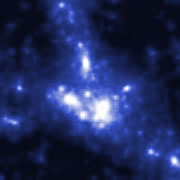International Space Station to search for dark matter of the Universe
A special device installed on board the ISS is said to prove the theory of dark galaxies
A superconductive magnet is to be installed on board the International Space Station. The magnet will be used to catch dark matter, antimatter and cosmic rays, the director of the Moscow-based Nuclear Physics Research Institute, Mikhail Panasyuk said. 
The Alpha Magnetic Spectrometer (AMS-2) project, in which American, Russian, European and Chinese scientists participate, has a goal to search for dark matter and antimatter and to measure space rays, the scientist specified. “The superconductive magnet will be placed in the center of the seven-ton device, which will be launched to the International Space Station in 2008,” the scientist added.
”Universe is presumably made of invisible matter, so-called dark matter. We know that the matter exists, but we do not know what it is made of. We hope that the AMS device will help us find an answer to this question and confirm the theory of dark galaxies' existence,” the scientist said.
The sensitive appliance is capable of catching elementary particles of anthelion. The device, which is about two meters in diameter and about three meters long, is currently being built at the Geneva-based European Nuclear Center, CERN. A shuttle will take the equipment to the International Space Station. An automatic manipulator will install the device on the surface of the station. The AMS installment is to work for not less than three years in space.
”The apparatus starts processing the information itself, the central computer is duplicated 16 times there. The computer of the ISS transmits the data to NASA, which subsequently sends the information to CERN and then to regional centers as well, including our research institute,” Panasyuk said.
The prototype of the Alpha Magnetic Spectrometer has already worked in space. The radar was catching cosmic rays in the cargo department of a shuttle in 1998. “The installation of the device will not disable the equipment of the ISS,” the Russian scientist said.
Specialists of the Nuclear Physics Research Institute have already developed and built the central part of the appliance – the semi-conducting tracking system. The system contains eight silicon detector plates. The latter perform mathematical modeling of possible failures in the operation of the electronic magnet, Itar-Tass reports.
Subscribe to Pravda.Ru Telegram channel, Facebook, RSS!





